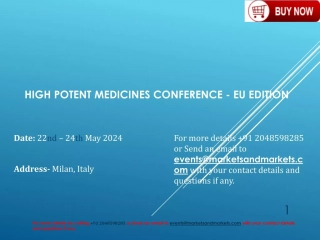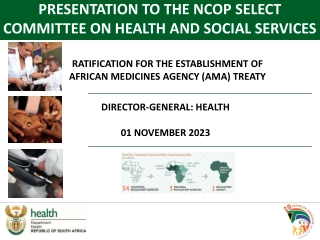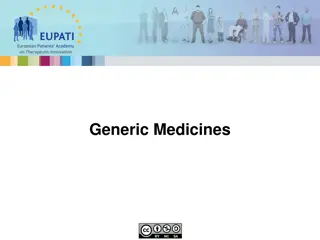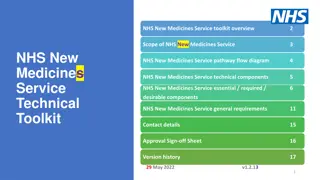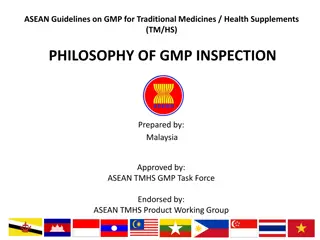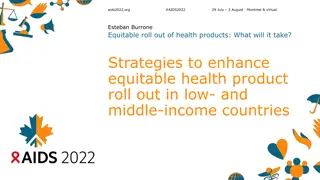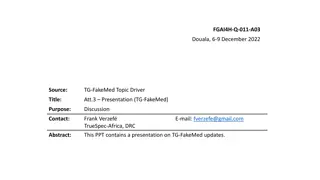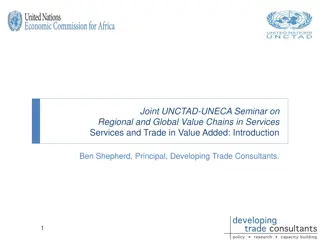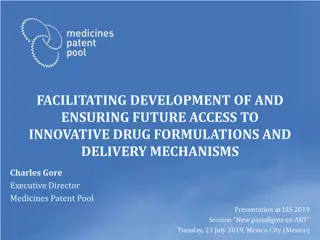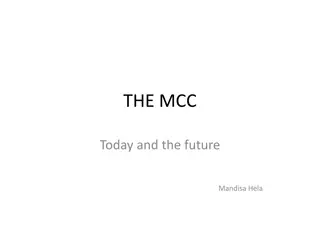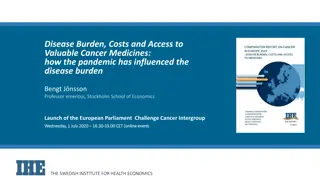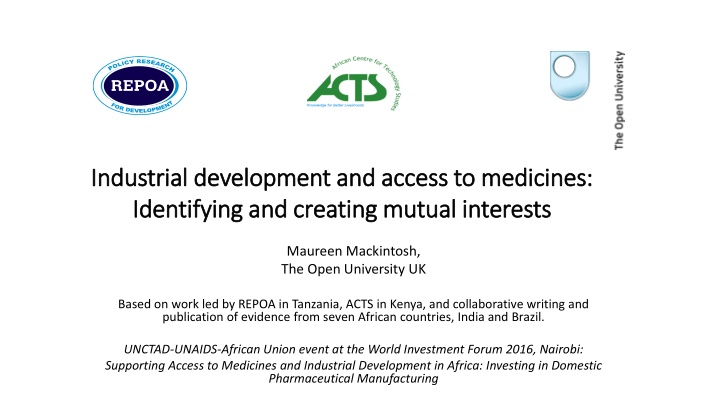
Creating Mutual Interests for Industrial Development and Access to Medicines
Explore the intersection of industrial development and access to medicines, focusing on identifying shared interests and incentives for sustainable systemic improvements. Examples include sustaining the supply of essential medicines, collaborative procurement, and supporting local market needs. Learn how cultural and procedural changes can enhance collaboration between health and industrial sectors to drive positive outcomes in healthcare access and innovation.
Download Presentation

Please find below an Image/Link to download the presentation.
The content on the website is provided AS IS for your information and personal use only. It may not be sold, licensed, or shared on other websites without obtaining consent from the author. If you encounter any issues during the download, it is possible that the publisher has removed the file from their server.
You are allowed to download the files provided on this website for personal or commercial use, subject to the condition that they are used lawfully. All files are the property of their respective owners.
The content on the website is provided AS IS for your information and personal use only. It may not be sold, licensed, or shared on other websites without obtaining consent from the author.
E N D
Presentation Transcript
Industrial development and access to medicines: Industrial development and access to medicines: Identifying and creating mutual interests Identifying and creating mutual interests Maureen Mackintosh, The Open University UK Based on work led by REPOA in Tanzania, ACTS in Kenya, and collaborative writing and publication of evidence from seven African countries, India and Brazil. UNCTAD-UNAIDS-African Union event at the World Investment Forum 2016, Nairobi: Supporting Access to Medicines and Industrial Development in Africa: Investing in Domestic Pharmaceutical Manufacturing
Effective and coherent policy requires more than health and Effective and coherent policy requires more than health and industrial policy makers talking to each other industrial policy makers talking to each other More health-industry policy debate is certainly needed. How can that be focused on practical systemic improvements? The core challenges are innovation and transformation in both health and industrial sectors, to identify and to generate shared interests and compatible incentives. Three examples of achievable systemic change: 1. A shared focus on sustaining competitive supply of, and access to off- patent basic essential medicines; 2. Cultural and procedural changes towards collaborative design of public, donor and non-profit procurement; 3. Innovation and upgrading support to address local market needs and ensure market access.
A shared focus on sustaining competitive supply of, and A shared focus on sustaining competitive supply of, and access to off access to off- -patent basic essential medicines patent basic essential medicines Local producers have been shown (in Tanzania) to achieve more effective rural distribution of basic medicines than importers/distributors; These basic medicines including broad spectrum antibiotics are generally low price and low margin, external competition having driven down prices and reduced local supply; Protection of this market e.g. by negative lists can sustain local manufacturers cash flow in competitive domestic markets; This in turn supports local firms investment and innovation capability where external finance is tight and expensive; It also sustains firms incentives to maintain wide domestic distribution networks that support access to medicines via shops and facilities.
Cultural and procedural change Cultural and procedural change towards of public, donor and non of public, donor and non- -profit procurement towards collaborative design collaborative design profit procurement Donor funding has improved medicines access, but procurement rules have raised market access barriers for local firms; Local firms report that public and donor-funded procurement carries increasing business risk; Approaches used by some non-profit wholesalers illustrate the scope for collaborative working with local firms to strengthen local supply chains; Improvements to build competitive domestic suppliers can include: Local tenders and smaller, more accessible tender sizes; Call-off and longer contracts with accredited local suppliers to support suppliers investment; Regular local supplier meetings to share information, resolve problems and identify opportunities; Trade credit for local as well as overseas suppliers; Ensuring tax, duty and procurement rules do not favour importers over local manufacturers; Stabilisation of donor and government procurement funding; Linking funding and technical support for upgrading to procurement commitments.
Innovation and upgrading support to address local market Innovation and upgrading support to address local market needs and ensure market access needs and ensure market access The local pharmaceutical sector is under constant regulatory and competitive pressure to upgrade; Firms need technical and financial support to invest, train and learn to sustain competitiveness, and they need market access while upgrading; External support can come from e.g.: PPPs such as DNDi, investing in one-off technological upgrading and GMP improvement; Joint ventures, such as A-Z textiles with Sumitomo to produce insecticide treated nets, or the Sino-Ethiopian joint venture to produce hard capsule shells; Technical improvement support from Kaizen initiatives, or from machinery producers/installers. When it goes wrong it is often from lack of market access, e.g. the Brazil-Mozambique joint venture to produce HIV medicines. Government can work with firms and external bodies to ensure that market access and regulatory effectiveness are in place to sustain upgrading initiatives.
F Further reading urther reading For evidence and frameworks of thought behind these very brief remarks, see: Mackintosh, M. Banda, G. Tibandebage, P. Wamae, W. (eds.) (2016) Making Medicines in Africa: the Political Economy of Industrializing for Local Health. Palgrave Macmillan, open-access under a creative commons licence, freely downloadable at http://www.palgraveconnect.com/pc/doifinder/10.1057/9781137546470 Mackintosh, M. Kale, D. Orsenigo, L. Simonetti R. (2016) Evidence submitted to the UN Secretary General s High Level Panel on Access to Medicines http://oro.open.ac.uk/46403/ Project website (policy briefs and working papers): http://iphsp.acts-net.org/ Collaborating research institutions websites: http://www.open.ac.uk/ikd/ http://www.repoa.or.tz/ http://www.acts-net.org/ Srinivas, S. (2012) Market Menagerie: Health and Development in Late Industrial States Stanford University Press.


